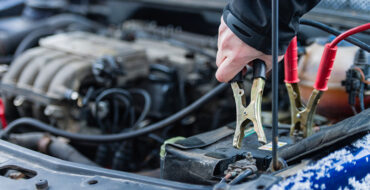A dead car battery can put a real damper on your travel plans. Let’s go over some common reasons why your battery may be dying and how to avoid them.
Why is my car battery dead?

Symptoms your battery is failing
If your battery is dying, your car may let you know with the following symptoms:
- battery warning light is on
- dim or flickering headlights
- no power from charging ports
- engine is slow to crank
You can check if your battery is the direct problem by measuring its voltage with a multimeter.
Should the multimeter indicate that your battery is fine, battery symptoms can also be an indication of other problems with your car:
- The alternator is wearing down. You can learn more about broken alternators here.
- The starter isn’t working. We have some information on faulty starters here.
- A broken wire may be draining energy from the battery. It’s best to have an auto technician investigate this problem.
If you have any questions about these issues, an expert at your local NAPA Auto Parts store can help.
Causes for a dead battery
There are several reasons why your car battery may die.
Extreme temperatures
The ideal outdoor temperature for a car battery is 27 °C. Of course, you will rarely drive your vehicle in exactly 27 °C weather, which is why your battery has been designed to withstand fluctuations in external temperatures. However, extremely cold or hot weather can prevent your battery from working properly.
Cold weather slows down the chemical reactions in your battery, making it harder for it to start. At the other end of the thermometer, too much heat can speed up chemical reactions to the point where they degrade the components inside the battery.
A block heater or battery blanket can help your battery stay cozy against the cold. To handle the heat, try to park in the shade and avoid small trips.
Power drainage
Using electrical components in your car while the engine is off will drain energy away from the battery. This includes charging devices and leaving the lights on (interior or exterior). Avoid running these outlets while your car is off to ensure the battery has ample power when you need it next. Instead, keep a portable phone charger and travel lamp in your car.
Corrosion
Battery corrosion is fairly unavoidable, but it’ll develop faster if the battery gets overheated or overcharged. Visible corrosion will be blue, green, or white. Over time, it’ll destroy your battery’s cables.
You can clean corrosion from your battery using baking soda, water, and a wire brush.
Age
Most car batteries last three to five years. If your battery is reaching the end of its lifespan, it may die more frequently.
Boost or replace
Although you can potentially prevent your car battery from dying, once it happens, you need to bring it back to life or swap it out to get your car moving again.
Sometimes you just need to give your battery a boost to get it back on the road. Follow these steps to boost your battery.
If your battery won’t hold a charge of at least 12.6 V after boosting, it’s probably time for a replacement. You can find a wide range of car batteries available on NAPACanada.com. Remember to input your car details in the top left corner of the website to be matched with products guaranteed to fit.
If you’re still experiencing battery-related issues after a replacement, have a professional assess your vehicle for problems with other parts.
For more advice on maintaining or replacing your car battery, visit your local NAPA Auto Parts store to speak with an expert.



